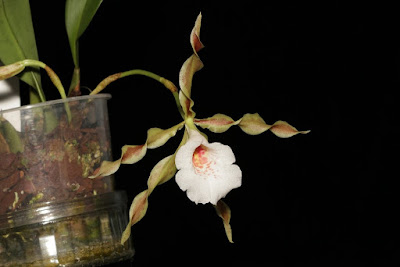Trichopilia tortilis is native to Mexico, Central America, Western Panama. This orchid grows in damp mountain rainforests, or in humid tropical forests. In Belize, the plants grow in the district of Toledo, in moist forests with broad, dense foliage...
Trichopilia tortilis also called as The Twisted Trichopilia, is a species of the genus Trichopilia. This species was described by John Lindley in 1836.
IDENTIFY TRICHOPILIA TORTILIS
Trichopilia tortilis is native to Mexico, Central America, Western Panama. This orchid grows in damp mountain rainforests, or in humid tropical forests. In Belize, the plants grow in the district of Toledo, in moist forests with broad, dense foliage, at an altitude of about 750 m, but they are rather rare. In Mexico, these plants are found in the southern state of Chiapas at an altitude of 900-1800 m. In Guatemala, they grow at an altitude of 1500 m or below, in the department of Alta Verapaz near Cobán, in the department of Guatemala near the city of Guatemala, as well as in the lower, southern the eastern slopes of the Santa María volcano in the Quezaltenango department. They are also found in other places. In El Salvador, they are located near San Vincente at an altitude of 1200-1500 m. In Honduras, they grow in the department of Comayagua at an altitude of 1200 m. In Nicaragua, they meet in the Jinotega department at heights of 1200-1330 m. In Costa Rica they grow in mountainous areas, but there is no additional information. In western Panama, plants are found in the Chiriquí province at heights of 1000-1300 m.
It is a medium sized, hot to warm growing epiphytic species, which reaching a height up to 30 cm, with oblong to cylindric, laterally compressed, 4-12 cm long and 1.2-2.0 cm wide pseudobulbs concealed by one or more brown spotted basal bracts carrying a single, subcoriaceous, elliptic-lanceolate, abaxially carinate, 9-22 cm long and 2.3-4.8 cm wide leaf with a conduplicate petiole at the base.
The Twisted Trichopilia flowers on a basal, pendulous, 5 to 10 cm long, slender, 1 to 3 flowered inflorescence, arising on a newly matured pseudobulb, that has tubular, scarious bracts and large, showy, fragrant, waxy flowers occurring in the spring and summer. The flowers are up to 15 cm in diameter. The petals of both whorls are narrow, clearly twisted, color from brownish-purple to light lavender and have irregular objections - yellowish to greenish. The large, tubular lip is white to yellow-white, in the yellow throat it has brown or scarlet spots, and the wide-angled edges are wavy or twisted.
TRICHOPILIA TORTILIS CARE AND CULTURE
Cultural information should only be used as a guide, and should be to be adapted to suit you. Your physical location; where you grow your plants, how much time you have to devote to their care, and many other factors, will need to be taken into account. Only then can you decide on the cultural methods that best suit you and your plants.
Light:
Trichopilia tortilis needs a light level of 12000-20000 lux. The surroundings should be rather shady with filtered, diffused light. The plant should not be exposed to extremely sharp light, because its quite thick leaves are easily burned. Strong air movement should be ensured all the time.
Temperature:
It is a plant with moderate thermal requirements. The average summer temperature is 24 ° C, the night 15 ° C, and the amplitude of daily fluctuations is 9 ° C. The average temperature of the winter day is 24-27 ° C, and at nights, which are slightly cooler than in the summer, the average is 12-14 ° C, which causes an increase in the daily amplitude to 10-14 ° C.
Humidity:
The Twisted Trichopilia needs the humidity of about 85-90% for most of the year, at the end of winter and early spring, falling to around 70%.
Substrate, growing media:
Trichopilia tortilis grow well attached to pieces of tree ferns or cork, with high humidity ensured and daily watering during the summer. During the dry and hot periods it may be necessary to water several times a day.
They can also grow in pots with a loose substrate, quickly draining excess water, which, however, contains substances that retain a certain amount, such as cut sphagnum moss or perlite. Wood charcoal is also often added to ensure the air permeability of the substrate and protection against acidification.
Repotting:
The plants should be replanted before the substrate begins to be less permeable. The most appropriate time of the year for repotting is the end of winter preceding flowering, as flowers and new growths appear almost at the same time. Therefore, the plants should be repotted when new roots start growing or only a little earlier. This allows the plants to acclimatize in a relatively short time and provides them with the least stress. This is very important, because the plants must acclimate to the additional stress caused by the approaching hot, dry, summer weather.
Watering:
Precipitation is moderate to heavy for most of the year. The cultivated plants should often be watered during active growth, but excellent drainage should be ensured, and the roots must dry a little between waterings. The substrate around the roots can never be desiccated or soggy.
Fertilizer:
The plants should be fertilized every week 1/4-1/2 of the recommended dose of fertilizer for orchids. A fertilizer with a high nitrogen content is beneficial from spring to mid-summer, and a fertilizer richer in phosphorus should be used in late summer and autumn.
Rest period:
In winter, Trichopilia tortilis may need less water when they do not grow actively, especially when grown at low light levels during short days typical of average latitudes, but they can never be completely dry.

















COMMENTS